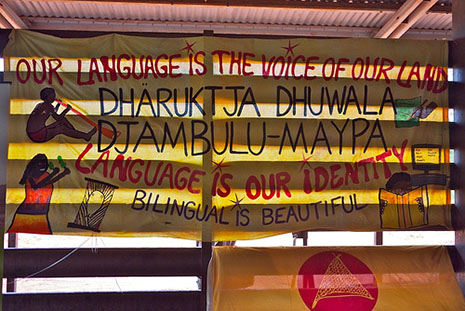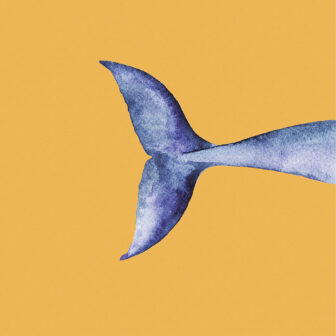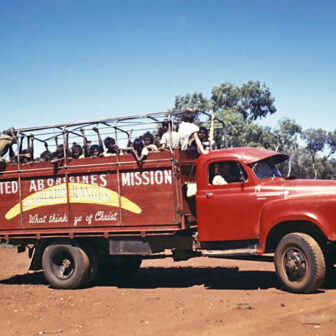WE’RE belting along a bauxite-red dirt highway in northeast Arnhem Land, crossing country covered with the short, spindly eucalypts that are endemic to the region. Tall termite mounds rise from the forest floor, guaranteeing that many of the tree trunks are hollowed out – ready for Yolŋu craftsmen to harvest to make the yidaki (didgeridoo), the signature sound in their repertoire. Not too many cars pass on this road between Yirrkala and the Laynha homeland of Garrathalala, so when a white Falcon flashes past our driver waves to the occupants. “That’s Djakapurra and his family,” he says. “You know, Djakapurra Munyarryan, the songman who danced with Nikki Webster and led the traditional welcome ceremony at the opening of the Sydney Olympics.”
It was not surprising that the ceremony was led by a Yolŋu songman. The music of yidaki player Djalu Gurruwiwi, the band Yothu Yindi and Geoffrey Gurrumul Yunupingu evokes the spirit of this spectacular country for audiences throughout the world. These are just a few of the high achievers in this society, who also include the brothers Galurruy and Mandawuy Yunupingu (both former Australians of the Year), the renowned actor David Gulpilil, Gatjil Djerrkura OAM, chairman of ATSIC from 1996 to 2000, and his son Nathan, who plays for the Western Bulldogs in the AFL. George Burarrwanga was the charismatic frontman for the Warumpi Band; among the many internationally acclaimed Yolŋu artists is David Malangi, one of whose designs was used on the reverse side of Australia’s $1 note in 1966 without his knowledge (he was subsequently compensated). Yolŋu have since helped to set up national mechanisms to prevent such exploitation of their artists and have vigorously defended their copyright, notably through a famous legal case in 1993 in which they successfully took action against the importers of carpets featuring stolen Yolŋu designs.
The Yolŋu were among Australia’s earliest international traders, maintaining trade and cultural exchanges with the Macassans for six centuries. Yolŋu warriors, under the leadership of anthropologist Donald Thompson, formed a formidable squadron to defend the Arnhem coast from Japanese attack during the second world war. Perhaps most significantly, Yolŋu launched the first land rights case in 1963, when they presented a bark petition to the federal parliament protesting against the annexation and destruction of their lands by bauxite mining giant Nabalco. The petition, written in both English and Yolŋu Matha, hangs in Parliament House, Canberra.
Yolŋu insist it is their “both-ways” or “two-way” philosophy, represented by the yambirrpa (fish trap) metaphor (pictured), that gives them the strength to defend their culture and their rights both in their own world and in the mainstream, and to make their unique contribution to the life of the nation. Mandawuy Yunupingu has written that “active participation of Aboriginal peoples will renew Australian life during the twenty-first century.” But, he adds, “it will need Aboriginal people who are strong and balanced, rooted in their families and their land. This will depend on Aboriginal people being educated as balanced contemporary Aboriginal Australians, something which will only happen when this education is inspired by their land.”
______
Right: This etching by Banduk Marika depicts the yambirrpa (fish trap) metaphor which is used to describe how, within the Yolŋu philosophy of education, the whole community works together to guide young people into Yolŋu foundations for learning. Everyone helps to build the yambirrpa from rocks, which represent the elders, and the fish are the children. The children learn inside the yambirrpa. Yolŋu say that sometimes big storms come from the outside which break or fragment the yambirrpa. They work together as a community to mend it by putting more rocks in place.
______
Three years ago, the Northern Territory’s education minister, Marion Scrymgour, announced that Territory schools “would have a greater focus on teaching English.” Her media release did not directly mention the Northern Territory’s bilingual education programs and none of the communities where the education department ran two-way programs were consulted or warned about the decision. The only detail provided in the announcement was that “the first four hours of education in all Northern Territory schools will be conducted in English.” There are five hours of instruction in the Territory’s school day.
The government’s decision undermined the achievements of the innovative two-way school curriculum that Mandawuy Yunupingu helped to pioneer. Community elders are deeply concerned that future generations will not be able to negotiate both worlds with the integrity, sophistication and success of current and past generations. The bilingual curriculum involves the coordinated use of Yolŋu Matha and English for instructional purposes and brings together Yolŋu and Western knowledge in teaching all subjects, including mathematics.
No review or study of the effectiveness of the two-way programs was undertaken before the announcement. Joe Lo Bianco, professor of language and literacy education at the University of Melbourne, says that some 1200 international studies provide empirical evidence of the effectiveness of bilingual education for students who do not speak the dominant language when they start school. In his booklet Indigenous Languages in Education: What the Research Actually Shows, Australian National University adjunct professor, Charles Grimes, cites 691 of them. “It’s easy to think that if you teach more English, students will learn more English. But that’s not how it really works,” Professor Grimes says. “Study after study shows that children learn best in the language they understand best. That should be obvious. Study after study also shows that where the primary language spoken in the home is not English, teaching them in both their own language plus English will improve their English far better than just teaching them in English alone. The evidence is overwhelming.”
News of the demise of the bilingual programs inspired a rush of protest letters to both politicians and the media. Yolŋu, already worn down by the impacts of the Intervention, were angered by the complete lack of consultation on the decision and expressed distress at the devaluing of their languages. “We have been told we are not to use our students’ first language, only English,” wrote educator Yalmay Yunupingu in an open letter to then education minister Marion Scrymgour. "Well, I already know that the children won’t understand what I’m saying, they will laugh at me, and they may even misbehave because they’ll be bored and won’t know what the lessons are about. So perhaps I will cheat and use some Yolŋu matha – what will happen then? Will I have my mouth washed out with soap like in the mission times? Or will I have to stand on one leg outside the classroom? Or perhaps I will lose my job?”
Until recently, these protests were largely ignored. This is despite the fact that bilingual education expert Associate Professor Brian Devlin, of Charles Darwin University, argued strongly in 2009 that the figures the government used to justify the decision were flawed, and that more recent statistics show how the demise of bilingual programs has already had an adverse effect. Devlin has shown that the statistics tabled in parliament excluded the award-winning Tiwi bilingual school at Murrupurtiyanuwu, and that the NAPLAN testing data was presented incorrectly. A 2010 study by Greg Dickson of the Australian National University showed attendance at Walpiri schools in Central Australia has declined dramatically since their bilingual programs were stopped. At Murrupurtiyanuwu, in the 2008 NAPLAN exams, Year 3 students performed “substantially above average” compared with similar schools in reading, grammar and numeracy; last year, students of the same age performed below average or equal to similar schools in those categories. At Lajamanu, about 870km south-west of Darwin, results in the reading and writing categories in last year’s NAPLAN tests were half of what they were in 2008 and this year attendance rates fell to just 37.2 per cent.
THE Northern Territory’s bilingual education policy dates back to two weeks after the Whitlam government came to power in 1972, when the new prime minister launched the first federal policy for Indigenous self-determination. The following year, Yirrkala was among the first communities to take up the opportunity to introduce a bilingual program. During its long life, the curriculum was developed through a unique Yolŋu approach based on a philosophy of creating new knowledge through the mixing of Yolŋu and balanda (Western) thought. A team of Yolŋu educators, most notably Mandawuy Yunupingu and Raymattja Marika, worked with balanda educators on learning programs, including the creation of the ganma maths curriculum, developed in partnership with mathematicians from Melbourne University, which teaches maths in the early school years through the patterns of the Yolŋu kinship system.
A review was conducted in 1974 and among its twenty-five recommendations was a proposal that the federal government should take steps to educate the public about the program. A short film on the approach, Not to Lose You, My Language, was produced in 1975, but no further efforts were made to encourage public discussion and understanding of bilingual education. The issue has inspired little media interest except on the few occasions when it has attracted controversy.
In this deeply monolingual country, the idea that everyone must assimilate to the dominant culture endures. The failure to explain and discuss the value of Indigenous languages means that they have not been recognised by the public or in law as national assets. This is not the case in some other post-colonial nations – including New Zealand, where Māori is an official language and taught in schools. There is also little popular or government support for the right of Australian Indigenous peoples, under article 14.1 of the Declaration on the Rights of Indigenous People, to control their educational systems and provide education in their own languages in culturally appropriate ways.
According to a former head of the NT Department of Education, it was the national news media’s intense spotlight on the Territory’s poor NAPLAN results in 2008 that motivated the policy change. “If you look, the media was actually the trigger behind all that policy change to go from bilingual to a four-hour, full-on English experience,” the former head said. “It was the national publication of results – the Northern Territory’s need to respond, to look like they were on top of this and handling it… There was no well constructed policy response as far as I could see. And nor has there been. It’s… almost a kneejerk response.”
A team of researchers led by Associate Professor Kerry McCallum of the University of Canberra is examining how Indigenous policies are developed in an increasingly media-saturated political environment. In this case, the NT government’s tight media management of the bilingual education issue on the one hand, and lack of journalistic resources on the other, hampered journalists in their coverage. One senior Northern Territory journalist who participated in the study said covering the 2008 decision to axe the bilingual policy was an exercise in frustration: “It’s such a shit fight to get even the statistics from the education department,” she said. “The length of time between when they were saying that bilingual schools weren’t performing and… when we got any kind of quantifiable data was ridiculous. Like months. And so it was repressive lines being fed by politicians, and then other opponents.” She was one of a number of reporters who described it as a complex issue that posed big challenges for inexperienced or disengaged journalists who did not understand the context of the debate.
People employed by the NT education department told researchers that they were reluctant to speak on the public record because it contravened department rules and they feared the repercussions. They gave examples of employees who were unsuccessful in applications for positions in bilingual schools or were moved out of schools because of their views and behaviour in regard to the “first four hours” policy.
Now, however, Yolŋu are hopeful that a federal inquiry into language learning in Indigenous communities will ask better questions and arrive at different conclusions from the Territory government. On 5 July this year the federal Indigenous affairs minister, Jenny Macklin, and her colleague, arts minister Simon Crean, asked the Parliamentary Aboriginal and Torres Strait Islander Affairs Committee to investigate the links between Indigenous languages and improving education, community well-being, interpreting services and strategies to close the gap in Indigenous disadvantage. The committee will examine how the use of Indigenous languages, particularly in early education, can help to improve education and vocational outcomes where English is a second language. It will also investigate the Indigenous languages policies of Australian governments and the effectiveness of Indigenous language maintenance and revival programs.
This inquiry follows the committee’s recent inquiry into Indigenous youth in the criminal justice system, which found that language is an important component of cultural connection, and strengthens intergenerational relationships and community building. Many people who made submissions to that inquiry referred to language as playing a significant role in the wellbeing of young Indigenous people.
The federal inquiry was announced in July and on 31 August the Territory government launched a new policy framework which enables “the relevant director of school performance” to consider “proposals for additional within-school opportunities to provide cultural and home language learning.” Schools must go through an exhaustive application process before the end of this year to be considered. While this softening of the “first four hours” policy offers Yolŋu some hope, they are indignant at having to apply for permission when they already have a sophisticated bilingual program that has met accreditation standards for decades. The relaunched policy contains no detail about how these language programs will be resourced, an issue that has been unresolved for decades.
WHEN we reach Garrathalala I meet senior teacher Multhara Mununggurr. She tells me about her father, Maw Mununggurr, an important ceremonial leader, veteran of the second world war squadron and an outstanding politician, painter, singer and dancer. She also tells me about her daughter, Yananymul Mununggurr, who was educated in a two-way Yolŋu school and is now the chief executive of the Laynhapuy Homelands Association.
“My strength, my strength is here,” she says, looking out at the land and sea. “I speak about my father. How I was taught. Because he’s not around the continuation of my study is challenging. But I got a fortune from my father – the greatest gifts. Now I’m passing that to my children. My daughter is CEO of the homelands – huge homelands across the Arnhem region. I have to build up that strength – passing the value from my dad and me. My daughter got that. Two granddaughters are teachers as well. My students, now my teachers.”
Multhara says Yolŋu children need their two-way education so they can link Western and Yolŋu cultures and knowledge together successfully. “It is very important for both Indigenous and non-Indigenous that everyone should share the ideas and the philosophy together,” she says. “The land is very important and our culture is very important as well, but there is more significance in both worlds – the two worlds – how our culture and napaki [non-Indigenous] live together.”
Multhara says she wants the opportunity to show journalists and politicians her country, explain how the two-way curriculum works and why it is crucial. They have not made the journey yet, but Yolŋu remain optimistic that the parliamentary inquiry will change that. •




